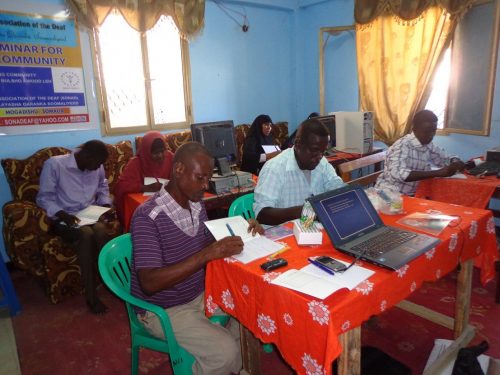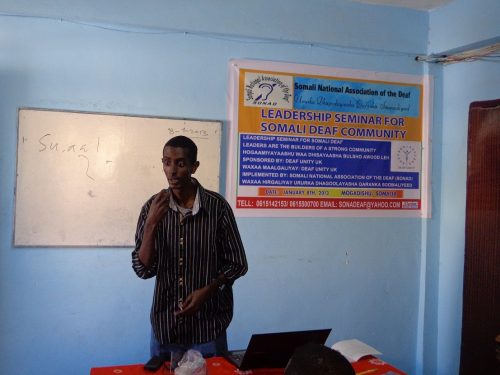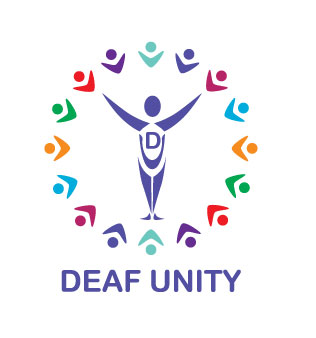Amidst the backdrop of war, oppression, struggle, victory, human rights and the rest that makes up the tapestry of Somalia, there is one group for whom the journey into the light is just beginning. Much has been written on the rights of women, on the rights of self governance and economic recovery, but little spotlight has been shone on the rights of the deaf: the unseen and unheard community.

Somali Deaf Workshop
Since the civil war of the 1990’s, there has been much attention on rebuilding facets of Somali civilisation, leaving little attention and even less resources for a community that was not even recognised before that era. Yet, on the horizon of the future, we see a new day dawning for the deaf of this land, a new hope that has been cresting for some time but is just starting to spread its warmth on the deaf community.
Across the world, deaf education has existed in some form since the 1500’s, beginning in force in Europe, spreading quickly across Western Europe and over the ocean to America. Yet, in Somalia, the story began in Borama, a township located in the westernmost part of Somaliland, nearest the Ethiopian border. Through the vision and work of the humanitarian, Dr. Annalena Tonelli, this deaf school was the first in Somalia, opening its doors in the late 1990’s to the deaf youth. Recent figures tell us that this school now serves 174 deaf, half of them girls, and provides grade one to grade eight education.
Since this epoch, two other deaf schools have been established. Hargeisa School for the Deaf was founded in 2001, the first and only in its region. In 2003, the Sound and Silent Primary school was founded in Mogadishu. The driver behind this leap forward has come, not from the governing bodies of the country, rather through the vision and drive of the local communities and outstanding examples of altruism, such as the late Dr. Tonelli.
Having seen and personally felt the exclusion and deprivation that comes from being part of a marginalised group, a demand has risen to the surface for basic human rights and access to information and education. From humble beginnings - meeting in donated rooms often without chairs or tables - each of these schools has evolved and grown to effectively serve their local deaf communities and its families.
Whilst the path to success has become more straight over the years, the development of a robust and native provision for the deaf youth has been slow in coming. The lack of a formal and naturalised sign language, the dearth of qualified and experienced educators and the constant fight for funding and support from NGO’s and government has hampered the growth and efficacy of these institutions.
The development of sign language in Somalia has not followed what one would consider the ‘natural course’. In most countries in Africa, the development of a national sign language would be preceded by the establishment of a school or institution. The institution might be founded by a hearing person or charity and would begin with a more oral approach. Through time, they would recognise the prevalence of a signing system in playground, which would then be brought into the classroom and the language would be born. In Somalia, however, there seemed to be a simultaneous inception of both language and institution. The establishment of the Boroma school in 1997 brought with it qualified deaf teachers from Kenya. The Wajir school in Kenya had forged strong links with Dr. Tonelli and deaf children from Somalia had crossed the borders to be educated at Wajir. The remittance of deaf, educated individuals from the Somali Diaspora kickstarted the use of sign language at the same time as curricula was being forged. Having the same culture, a strong sign language in Kenyan Sign Language, and a full education, the school leapt the normal hurdles of beginning on this path to deaf education and inclusion. Though a Kenyan Sign Language (KSL) was used, this was quickly naturalised and a Somali Sign Language (SSL) has been developing over the years. Though still heavily influenced by KSL, it is still more culturally appropriate and relevant than say, American Sign Language. This initial start was given greater force by the addition of two educated deaf women from Wajir, one of whom was then to assist in starting the Hargeisa school, in the capital of Somaliland.

Deaf Leadership training Somalia
The reaction and support of the local community has been a major factor in the development of a deaf education provision thus far. Presentations have been delivered to different groups, including women’s groups. Teacher training colleges and universities were given basic deaf awareness and pedagogy techniques, and the first maternity nurse trainees also received training. Deaf organisations began to form, with 2006 seeing the Somali Deaf Union (SODO) being formed, with the aim of uniting Somali Deaf in Mogadishu and southern Somalia to advocate for their rights. This was followed a year later, in April 2007, with the formation of the Somali National Association for the Deaf (SONAD). In Hargeisa, the Deaf Youth Organisation (DYO) and the Hargeisa School for the Deaf Parents Committee (HSDPC) were the protagonists in establishing the Hargeisa school. This constant positive support from its local community has enabled each school to grow in size, secure improved locations for their work and gain resources to effectively promote deaf education in their regions. Support has been erratic from NGO’s and LNGO’s, at times cutting support with little or no explanation. Quickly scanning each of the school’s websites shows a state of constant appeal for funds, for lands, for support.
So how can the Diaspora help in continuing the good work accomplished so far and bring deaf education on to a par with that of the rest of the world?
Sign Language
Those who work in the area of sign language research and linguistics could give attention to documenting the emergence of SSL. Its roots in KSL must be recognised and the divergence be recorded, in order to give SSL its own identity as opposed to being a ‘derivative language’. A deaf expert from Zambia previously visited Somaliland and his helpful report identified errors and lack of knowledge of signs on the part of the teachers. There was no official record, however, or training to remedy the shortfalls identified. For the language to become naturalised, it must be understood. More than twenty years have passed since the schools’ inception, and the language’s official use in education. It cannot afford another twenty years to pass before research is conducted. A sign language dictionary has been started by the Hargeisa school for the deaf, sponsored by the AngloSomali Society. This is a limited, draft document that needs to be corroborated and contributed to by experts in the field.
Education
The first deaf school was started by a Kenyan responding to a need and providing his experience and expertise to support the work of Dr. Tonelli. Whilst the support of local groups and NGO’s for funding is vital, experienced advice and professional nurturing is needed. Over the years, a few schools and colleges across the world have given assistance to the deaf schools in Somaliland. The Henley College, England, is one such establishment that over the years provided support. Yet, this could be built on by twinning schools in the UK, USA and other leading countries in the field of education to share best practice and learning for the benefit of staff and pupils alike. It would be amazing to see links being forged across borders that would mean these schools could draw on the successes and mistakes of their predecessors and prevent more suffering for their students as the path ahead is carved. Even better, qualified educators who are members of the Diaspora could give their time to return to Somalia to train and give professional advice to the educators currently involved.
Stable Support
Through the years, many groups and organisations have lent support to the deaf schools and their sponsoring organisations. It seems though that often this is short lived, or erratic at best. Understandably, trying to navigate political barriers in a country of unease and unrest can cause many to shy away from a protracted relationship. Again, this is where the Diaspora can step in and try to bridge the gap in a more structured way and one that could provide longevity. Organisations like the National Deaf Children Society (NDCS) and Deaf Unity are two examples of organisations from the UK that have identified a need and are promoting awareness in Somaliland. In the case of Deaf Unity, whose CEO is Somali, they have teamed up with SONAD to share their expertise in leadership and empowerment, training 12 community members in deaf identity and in development strategies for SSL. They have also conducted fundraising activities with a Diaspora organisation based in London, England. It is this kind of Diaspora remittance and assistance that will ensure longterm support, as it is Somali people helping Somali people.
Seeing the Diaspora reach back to their homeland, seeing the successes and learning being poured back into the country, one can begin to dare to hope for a better future for the deaf education provision on Somalil. A more robust education provides a more robust workforce, opening up new opportunities for the deaf and their communities alike. Let us do our part to make that future a reality.
References:
http://www.eenet.org.uk/resources/docs/somali_sign_language.php http://www.hsdeaf.org/aboutus.php https://deafunity.org/2013/01/deafunityandsnadunitetopavethewayfordeafsomalis/

